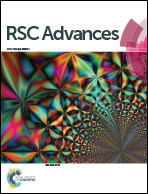Fluorescence alarming ON–OFF–ON switch derived from biocompatible carbon nanoparticle–hemoglobin–H2O2 interaction†
Abstract
The present study comprises a deeper comprehension on the applicability of environmentally benign water soluble fluorescent Carbon Nanoparticles (CNs) synthesised from jamun (Syzygium cumini). We have synthesised two types of CNs i.e., surface non-passivated and surface passivated. The morphological investigation of either type of CN shows a narrow particle size distribution with an average size of 40 nm and 42 nm respectively. These CNs show potential candidacy as cell imaging agents due to cell viability up to a high concentration of 30 μg mL−1 as revealed by cytotoxicity analysis. Furthermore, we employed hemoglobin as a target to explore the biosensing ability of CNs based on a turn ON–OFF mechanism. Moreover, we have made a reversible fluorescent turn ON–OFF–ON switch taking the CNs–Hb composite system in conjugation with a large excess H2O2. This unbelievable fluorescence enhancement of the CNs–Hb composite system on exposure to excessive H2O2 is due to a decrement in particle size that conversely increases the surface area to volume (S/V) ratio which in turn intensifies the PL spectra. Using the above intriguing changes, a nanoparticle based implication logic operation (IMP) was created with Hb and H2O2 as inputs.


 Please wait while we load your content...
Please wait while we load your content...